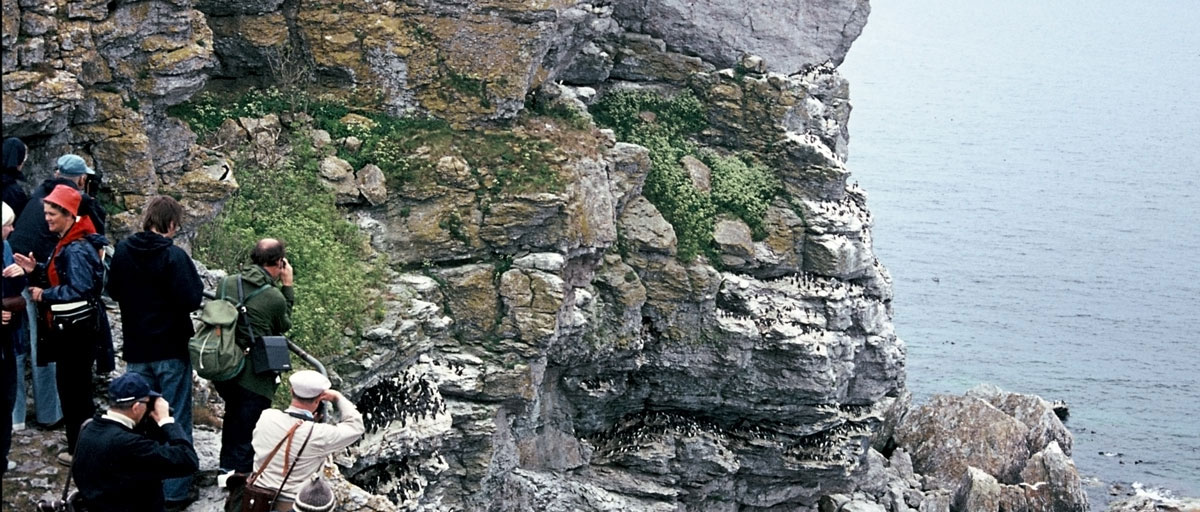
The population of common guillemots on Stora Karlsö is increasing, though globally populations are in decline. A new study has looked at photos from the past century to establish the population trend for that period. Photo: L.-E. Norbäck (1975)
Bildtext får vara max två rader text. Hela texten ska högerjusteras om den bara ska innehålla fotobyline! Photo: B. Christensen/Azote
Marine ecosystems
Less common in the past
Unique collection of tourist photos shows that Baltic Sea common guillemots are at historically high levels today
- Population of common guillemots in the Baltic Sea is currently increasing at an unprecedented rate of about 5% annually
- Breeding birds have been counted in photographs from the Swedish island of Stora Karlsö between 1918 and 2005
- The collection of photos also shows that the guillemots declined early in the 20th century
Centre researchers Jonas Hentati-Sundberg and Olof Olsson have reconstructed a unique, almost a hundred years long time series of the population trend of common guillemots in the Baltic Sea.
Their study is published in the journal Current Biology and based on a count of the number of breeding birds in photographs from the Swedish island of Stora Karlsö between 1918 and 2005. The results were then complemented with a detailed photo documentation of the colony from 2006-2015.
"We found that the population is currently increasing at an unprecedented rate of about 5% annually," says Jonas Hentati-Sundberg. "This is interesting seeing as many common guillemot populations are decreasing worldwide."
Filling a gap in the scientific record
Stora Karlsö became a nature preserve and hunting park already in 1880. To help fund the venture, owners of the island began organizing tours in the 1920s. Stora Karlsö remains a popular tourist destination, attracting about 10,000 visitors each year. And that means that the colony of seabirds living on the island has had its picture taken over and over again, for almost 100 years.
The collection of photos shows that the guillemots suffered early in the 20th century, but their numbers have now risen to a historically high level. The analysis also demonstrate the power of amateur photos and other unconventional sources of evidence to help fill important gaps in the scientific record.
"Seabirds are both integral to the marine ecosystem and at the same time easily observed and charismatic, and therefore a kind of terrestrial messenger of sub-surface dynamics"
Jonas Hentati-Sundberg, lead author
Before the island received protection, local people collected guillemot eggs and also harvested adult birds. That practice ended in the late 19th century, but the birds faced other pressures over the years, including oil spills and chemical exposures. They also got tangled in various forms of fishing gear.
Five-fold increase
Long-term empirical datasets are necessary to examine human impacts on marine ecosystems, but standardized scientific inquiry generally only dates back 30 to 40 years. Given the history of the island, Hentati-Sundberg and Olsson knew there must be plenty of old photographs of the island and its seabirds. They spent about 5 years collecting images from archives, museums, and especially from people who had visited the island and photographed its main attraction: the seabird colonies.
Those photos show that today's island colony of guillemots is more than five times bigger than it was in the early 20th century. The researchers also observed a dip in seabird numbers between the 1960s and 1970s, a time when environmental contaminants such as DDT and PCB are known to have been extremely high in the Baltic Sea
"It is reasonable to expect that contaminants had a role in the decline," Hentati-Sundberg says. "It has not been known previously that seabird populations were affected by the contaminants."
A flying messenger
Hentati-Sundberg suggests that the current increase in the guillemot population on Stora Karlsö might trace to a combination of factors, including a ban on driftnet fishing for salmon in the Baltic Sea enacted in 2008, a decline in environmental contaminants, and an abundance of small fish that guillemots like to eat. "It will be very interesting to see how long the increase can go on," he says.
The seabird photos can reveal important trends in the larger marine ecosystem.
"Seabirds are both integral to the marine ecosystem and at the same time easily observed and charismatic, and therefore a kind of terrestrial messenger of sub-surface dynamics," Hentati-Sundberg says.
Future research will be focused on learning more about the factors driving the rise and fall of the birds in the 20th century. In particular, the researchers hope to find out more about the links between the seabirds and their fish prey.

Glass plate photography of the common guillemot colony on the island of Stora Karlsö in 1918. Photo: P. Rosenius/Vänersborgs museum collection
Hentati-Sundberg, J. and Olsson, O. 2016. Amateur photographs reveal population history of a colonial seabird. Current Biology 26: 226–228. http://dx.doi.org/10.1016/j.cub.2016.02.007
Jonas Hentati Sundberg finished his thesis on long-term changes in the Baltic Sea in December 2015. Read more here
Olof Olsson is managing director at the centre. His research interest is mainly in trophic interactions in marine ecosystems and seabird life-history and behaviour ecology. He currently runs a research project on seabirds and marine food-web interaction in the Baltic Sea.






